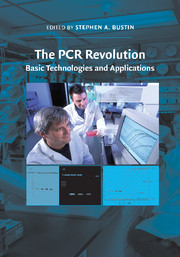Book contents
- Frontmatter
- Contents
- Contributors
- Foreword by Russell Higuchi
- Preface
- I BASIC TECHNOLOGIES
- II APPLICATIONS
- 10 Polymerase chain reaction–based methods for the detection of solid tumor cancer cells for clinical diagnostic and prognostic assays
- 11 Polymerase chain reaction and infectious diseases
- 12 Polymerase chain reaction and respiratory viruses
- 13 Polymerase chain reaction and severe acute respiratory syndrome
- 14 The MMR vaccine, measles virus, and autism – A cautionary tale
- 15 Noninvasive prenatal diagnosis using cell-free fetal nucleic acids in maternal plasma
- 16 Polymerase chain reaction–based analyses of nucleic acids from archival material
- 17 Microarrays and quantitative real-time reverse transcriptase–polymerase chain reaction
- 18 Polymerase chain reaction in the detection of genetic variation
- 19 Polymerase chain reaction: A blessing and a curse for ancient deoxyribonucleic acid research
- Index
- Plate section
- References
15 - Noninvasive prenatal diagnosis using cell-free fetal nucleic acids in maternal plasma
Published online by Cambridge University Press: 25 January 2011
- Frontmatter
- Contents
- Contributors
- Foreword by Russell Higuchi
- Preface
- I BASIC TECHNOLOGIES
- II APPLICATIONS
- 10 Polymerase chain reaction–based methods for the detection of solid tumor cancer cells for clinical diagnostic and prognostic assays
- 11 Polymerase chain reaction and infectious diseases
- 12 Polymerase chain reaction and respiratory viruses
- 13 Polymerase chain reaction and severe acute respiratory syndrome
- 14 The MMR vaccine, measles virus, and autism – A cautionary tale
- 15 Noninvasive prenatal diagnosis using cell-free fetal nucleic acids in maternal plasma
- 16 Polymerase chain reaction–based analyses of nucleic acids from archival material
- 17 Microarrays and quantitative real-time reverse transcriptase–polymerase chain reaction
- 18 Polymerase chain reaction in the detection of genetic variation
- 19 Polymerase chain reaction: A blessing and a curse for ancient deoxyribonucleic acid research
- Index
- Plate section
- References
Summary
Prenatal diagnosis is now an established part of the modern obstetrics practice. For genetic and chromosomal analyses, however, conventional definitive methods for prenatal diagnosis would typically start with the invasive sampling of fetal materials, using procedures such as amniocentesis and chorionic villus sampling. These procedures are associated with a finite risk to the fetus. Thus, over the last forty years, many researchers have attempted to develop methods for noninvasive prenatal diagnosis that do not carry such a risk. In particular, much effort has been spent on the development of noninvasive methods for screening certain chromosomal aneuploidies, especially trisomy 21. Approaches such as ultrasonography and serum biochemical screening have been developed for this purpose. Although the recent developments in these approaches are remarkable, these methods essentially measure epiphenomena that are associated with chromosomal aneuploidies and do not analyze the core pathology of these disorders – namely, the actual chromosome abnormality.
To allow the direct analysis of this core pathology, a noninvasive source of fetal genetic material is needed. Investigators in this field have initially targeted fetal nucleated cells that may have entered into the maternal circulation, including trophoblasts, lymphocytes, and nucleated red blood cells. However, the extreme rarity of such cells in the maternal circulation (of the order of a few cells per milliliter of blood) has been a major impediment to the development of the field.
- Type
- Chapter
- Information
- The PCR RevolutionBasic Technologies and Applications, pp. 243 - 253Publisher: Cambridge University PressPrint publication year: 2009



